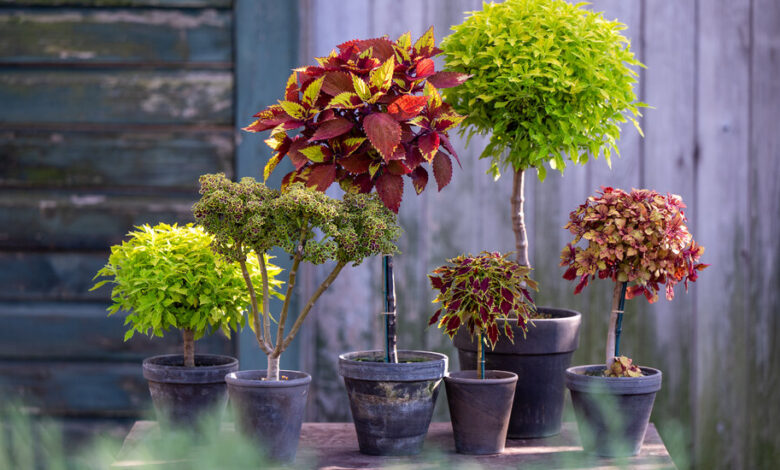How to Grow Potted Topiaries

Have topiary (and eclipse glasses), will travel.
Ken Selody, of Atlock Farm, put out the word in January: He had researched the path of totality of this week’s solar eclipse and considered optimal viewing possibilities. In early April, he planned to be Texas-bound.
“If I drove my van full of topiary through Tennessee, Arkansas and Texas,” Mr. Selody, who is based in New Jersey, asked on Instagram, “are there people or shops that would be interested in having me stop?”
This is how the popular topiary artist, whose longtime clients include Martha Stewart, rolls these days in his high-top white Nissan. Yes, the nursery is open for retail sales on Saturdays, but Mr. Selody also makes house calls.
Mr. Selody loves a good road trip, and when he opens the back of the van at his destination — the built-in shelves stuffed with lollipop-, tower- and spiral-shaped potted plants fashioned from myrtle, rosemary and more — those on the receiving end seem delighted, too.
But wait: What are those flashy colored plants among the payload — the ones with leaves not of green but gold, or maroon splashed with yellow? Are those Coleus standards?
“Nobody who has seen a Coleus topiary has ever said to me, ‘Oh, that old thing?’” Mr. Selody said.
Seeing that most familiar of springtime garden-center offerings transformed in this way elicits smiles — and questions about how topiary happens.
The Quickest Topiary: Coleus
Mr. Selody founded Atlock Farm in 1987 in Somerset, N.J., on a piece of the family turf-grass farm where he was raised. Later this spring, he is moving his nursery into greenhouses 25 minutes away, in Neshanic Station.
Ornamental horticulture became a hobby while he was studying photography in college, and he saw his first topiary sometime around then, in “this big tidal wave of English garden style coming over from there, in all of the new books full of color photographs,” he recalled.
Over the years, he has applied the technique to a number of perennial species. Many trees, shrubs, sub-shrubs and even vines can become topiaries, he has discovered, but some are easier, better or faster.
“You can plant an oak tree in your front yard, or in a pot for that matter, and turn it into a topiary,” he said. “Or a plant that would normally creep, like a thyme plant, can be staked and turned into a topiary.”
His most popular topiary offering is Myrtle (Myrtus communis), which can take up to three years to go from a cutting to a finished, two-foot-tall standard with a head the size of a soccer ball. Rosemary is among the easiest, and Eugenia myrtifolia, a myrtle relative, is pretty fast and cooperative. His palette extends to Euonymus fortunei and lavender (the Lavandula hybrid Goodwin Creek Grey), lavender cotton (Santolina chamaecyparissus), and even fuchsia and chrysanthemums, as well as scented geraniums and some of the smaller zonal Pelargonium.
But Coleus, which takes just six to nine months from cutting to finished standard — the classic shape of a tall, single stem topped by a foliar globe — has them all beat for speed.
He can’t remember when he trained his first Coleus. Certainly, it was decades ago.
Although it is marketed to gardeners alongside annuals for seasonal color, Coleus is perennial in its tropical or subtropical places of origin. For those curious about how topiary works, there is perhaps no better introductory plant, he said, but not all of the dizzying varieties out there are equally suited to training.
To get a fuller, denser head, a variety with closely spaced internodes — the section of stem between nodes, or growth points — is desirable.
“If you have a plant with really long internodes, you’re going to have to make this great, big, monstrous head of a thing,” Mr. Selody said. “It’s going to take longer, and it’s going to look really awkward for a very long time.”
Smaller leaf size generally indicates a better candidate, too.
What’s undesirable? Coleus varieties that are inclined to flower early, which is an impediment, especially while you’re training the supporting stem before shaping the lollipop on top.
When that happens, he said, it’s as if the plant “self-pinches,” terminating its own leader, or central growth point, and forcing side shoots to form instead.
“It’s not such a big deal once you have the head on it,” he said. “But when you’re trying to grow the stem up, and every three inches the central leader forms a flower, you have to use the side branch that comes from behind it instead, and you don’t get a nice, straight stem.”
‘They Need Almost Daily Attention’
The trickiest part for the gardener who is new to potted topiaries of any species? Not getting too attached. In the average household, Mr. Selody said, these are not forever plants.
Given the exact conditions he provides in his greenhouse, a potted topiary could live for decades. But they also need something more.
“There are people who have perfectly good conditions,” he said. “But they might like to go away for a week. And these plants are like I.C.U. plants — they need almost daily attention.”
So if you’re planning even a long weekend away, make sure you get a plant sitter.
Knowing all of that, do you dare surrender to a whirlwind romance of a year or maybe two with one of these incredibly charismatic creatures? Of course, Mr. Selody votes “yes.”
“People spend money on scented candles and expensive shampoo and bars of soap, or on chocolate-covered strawberries and cut flowers and bottles of wine that are gone in 15 minutes, and they think nothing of that,” he said. “But somehow when it’s a plant, it’s a different story. I see my job as sort of giving people special dispensation to believe that they don’t have to have it forever.”
In your togetherness time with any topiary (not just Coleus), remember these relationship-enhancing essentials.
Trim regularly: Don’t let the plant get misshapen and then inflict a severe haircut on it.
Water regularly, too: That can be as often as daily, especially if your topiary is in a small pot outside in summer.
Fertilize: “These plants eat more than you think they eat,” Mr. Selody said. Because organic fertilizers like fish emulsion have very low concentrations of nitrogen and other elements, he recommends a monthly application of a water-soluble food labeled with a 20-20-20 NPK ratio instead.
And finally: Be a partner your topiary can count on.
“It’s imperative that you do for your topiary plant what nobody else will do for you,” he said. “You have to remove all the stress from its life.”
Step by Step: How to Start a Coleus Topiary
Begin by making a cutting from a Coleus stem that hasn’t already been pinched, so that the growth tip at the top of the cutting (also known as the leader) is intact. Removing the tip will promote lateral branching — which you don’t want — and redirecting the resulting errant shoot to make it vertical “almost always leaves a little jog in the stem,” Mr. Selody said.
Coleus cuttings will root anywhere along the stem, and they’ll root easily in soilless potting medium in pots, cells or flats. Mr. Selody sticks his into trays of Oasis wedges — similar to floral foam — sold specifically for propagation.
When the roots have formed about two weeks later, move each cutting into a four-inch pot of soilless mix.
Over the next few months, direct each plant’s energy to straight upward growth by removing all side shoots that form along the stem, and also most of the leaves, allowing maybe seven to nine leaves to remain for photosynthesis.
As the plant grows, position a bamboo cane so that it reaches just above the desired stem height, securing it with a raffia tie to provide support.
When the stem reaches your target height — perhaps at six or nine inches — identify three pairs of upper leaves to incorporate into a head. The middle set should be at the very top of the bamboo, with one set below and another above. At this point, remove any lower leaves.
It’s now time to pinch out the central leader. This is a signal to the plant to force lateral growth from those six leaf nodes. Each one will form its own central leader, known as a lateral; it behaves like a central leader, but grows sideways. Those laterals will need pinching in time, too, as they push more growth, encouraging a third group of branches, as the head architecture develops exponentially.
“You pinch or snip six times, and then you’re going to go to 12, and then you’re going to go to 18,” Mr. Selody said. “You have to start out with a two-inch ball. A two-inch ball goes to a three-inch ball; a three-inch ball goes to a four-inch ball. And you have to keep growing it that way. There’s no shortcut.”
Margaret Roach is the creator of the website and podcast A Way to Garden, and a book of the same name.
If you have a gardening question, email it to Margaret Roach at gardenqanda@nytimes.com, and she may address it in a future column.






